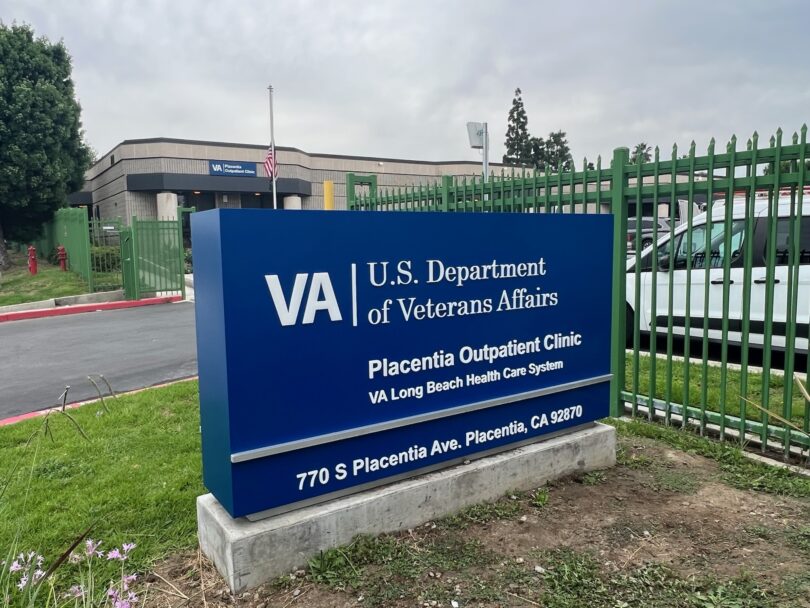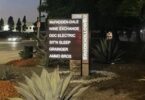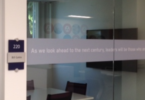At Stanco Signage Systems, every project holds significance. Still, when tasked with designing, building, and installing signage for the U.S. Department of Veterans Affairs in Placentia, California, we recognized the profound honor involved. As a veteran-owned business, serving military and veteran organizations carries personal importance, reflecting our commitment to supporting Veterans.
This article delves into the project’s intricacies, exploring the design process, advanced fabrication techniques like CNC-cut lettering, and the rigorous installation required for the exterior monument signs. Let’s walk through each stage that brought this remarkable signage to life.
Initial Consultation: Honoring the Mission and the Veterans We Serve
At the start, our team consulted with VA representatives to understand their vision and requirements for the signage. Beyond functional requirements, the VA signage must communicate the institution’s dignity and commitment to serving veterans and their families. As a veteran-owned business, we understood the importance of creating a welcoming and supportive environment for veterans relying on these signs for direction and information.
Our objective was to create visually striking signage that was durable enough to withstand Placentia’s outdoor elements. Monument signs, especially for government facilities like the VA, require particular attention to detail, materials, and regulatory compliance. Our team meticulously planned every detail, from the design concept to material selection, fabrication, and installation.
Designing for Functionality and Impact: The Monument Sign Concept
Designing monument signs for the VA facility required an approach that balanced functionality, visibility, and aesthetic quality. Monument signs are permanent installations that convey a strong presence and enhance brand recognition. For the Department of Veterans Affairs, this meant a design communicating strength, stability, and honor.
At Stanco Signage every detail matters in preparation for the final installation.
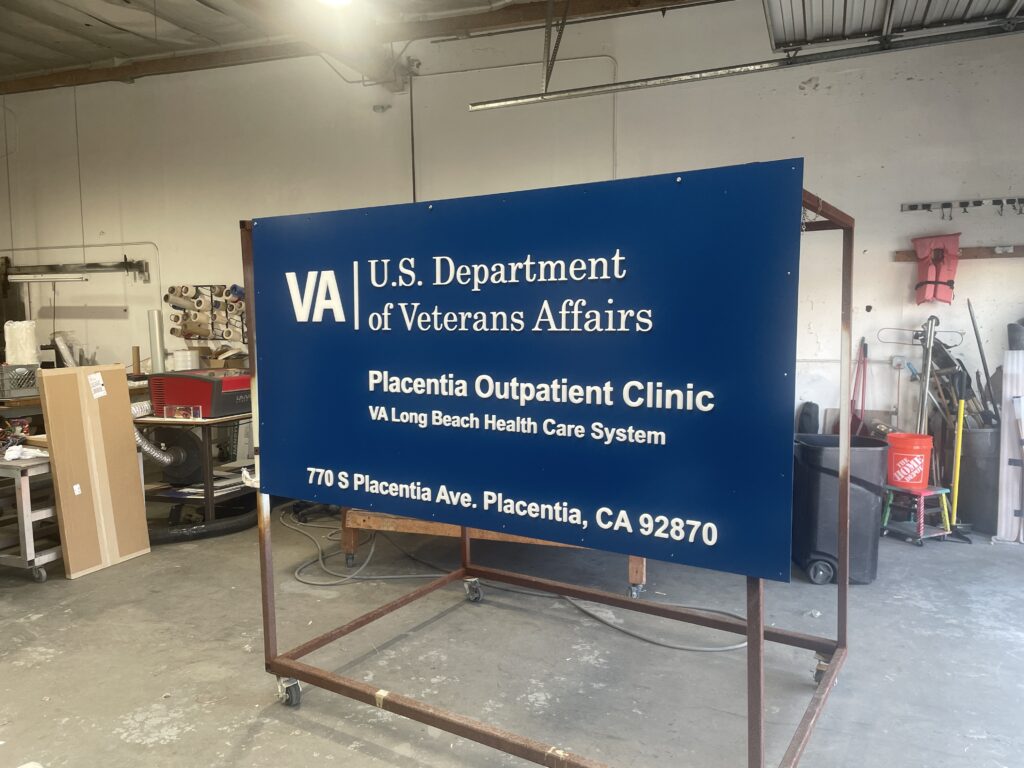
1. Materials Selection: Our first step was selecting materials that could endure the local climate while maintaining a polished appearance. We chose high-quality, weather-resistant materials, including aluminum and durable composites. Aluminum provides an ideal blend of durability, lightweight properties, and rust resistance, making it perfect for an exterior monument sign exposed to various weather conditions.
2. Color Scheme and Branding: The color scheme was carefully chosen to align with the Department of Veterans Affairs branding. We incorporated deep blues and crisp whites to evoke a sense of authority and respect, matching the government’s established color guidelines. The colors were also selected for visibility and contrast, ensuring that the signs would be easily read from a distance.
3. Lettering and Logo Design: Precision in lettering and logo design was critical. CNC fabrication technology allowed us to achieve the crisp, exacting detail required for the VA’s logos and typography, resulting in a finished product that looked professional and welcoming.
4. Architectural Lighting Options: While the VA decided against illumination, our design considered the potential to add LED lighting. Integrating this feature would ensure the signs remain visible after dark, helping veterans and visitors navigate the facility at all hours.
CNC Fabrication: Precision in Crafting Lettering and Logos
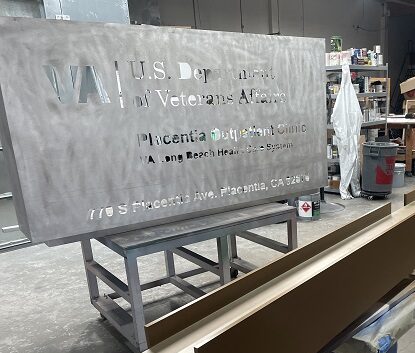
At Stanco Signage, our CNC fabrication systems create consistent and sharp detail, which is the ideal solution for government signage.
Once the design was approved, we moved to the fabrication phase. Utilizing CNC (Computer Numerical Control) technology, we brought our design to life with unmatched precision. CNC fabrication involves using computer-controlled machines to cut, engrave, and shape materials according to the exact specifications of the digital design.
1. Why CNC? CNC technology is invaluable for projects requiring precise, repetitive cuts, such as creating lettering and logos for monument signs. The CNC process ensured that each letter and logo detail on the VA signage was consistent, sharp, and accurate to the design’s specifications. CNC fabrication was the ideal solution for government signage, where brand integrity and consistency are paramount.
2. Fabricating the Lettering: We selected durable composite materials for the lettering for CNC cutting. Each letter was cut individually to ensure a three-dimensional effect that would catch the eye and enhance readability from various distances. These raised letters contribute a professional, high-quality appearance, ensuring that the signage is a focal point on the VA’s campus.
3. Assembling the Signage Components: After cutting, we assembled the letters, logos, and background panels in our workshop, where each piece was meticulously inspected for quality. We completed finishing touches, such as painting and protective coating, to add durability and resistance to the elements.
Exterior Build and Development: Constructing a Sign Built to Last
The exterior build of the monument signs required a robust and weatherproof structure that would endure the elements without degradation. This step was essential, as signs exposed to outdoor conditions must withstand natural and man-made wear.
1. Creating the Foundation: The signage structure began with a reinforced concrete foundation, essential for stabilizing the sign and preventing shifting or tilting over time. The concrete base was also treated to withstand moisture, reducing the risk of structural deterioration.
2. Mounting the Signage Panels: We mounted the aluminum panels, securely affixing them to the concrete base to prevent movement. The panels were treated with anti-corrosion coatings to ensure the aluminum would resist rust, particularly in humid or rainy conditions.
3. Weatherproofing: We added a protective coating over the panels and lettering to further protect the signage. This coating guards against UV rays, which can cause colors to fade over time, and acts as a barrier to dust and dirt, keeping the signs looking clean and vibrant.
4. Finishing Touches: The build’s final stage involved adding additional details, such as tactile features for accessibility. Although not required for this project, our team remains dedicated to providing accessible solutions when needed, ensuring that all veterans and visitors can easily navigate the facility.
Installation Day: Bringing the Project to Life
After completing the signage, it was time to install it at the VA facility in Placentia. Installation is always an intricate part of the process, as it requires precision and coordination to ensure the final product reflects the initial design and is secure for the long term.
1. Site Preparation: Our team prepared the installation site by measuring and marking the designated areas, aligning them with the intended placement and orientation of the monument signs.
2. Heavy Equipment and Safety Protocols: Given the size and weight of the signage, we used specialized equipment to lift and position each monument sign accurately. As a veteran-owned business, safety is paramount to us. Our team adhered to strict safety protocols to ensure a smooth installation with minimal disruption to VA operations.
3. Final Adjustments and Quality Check: Once positioned, the signage was secured in place, and we conducted a thorough inspection to confirm it was level, aligned, and securely mounted. This quality check verified that the lettering was readable and the colors were consistent with the approved design.
A Tribute to Veterans: Reflecting Our Values Through Quality Signage
This project for the Department of Veterans Affairs was more than just another signage installation for us. As a veteran-owned company, it was an opportunity to support and honor those who have served our country. By providing high-quality signage, we aimed to contribute to an environment where veterans and their families feel respected, supported, and guided.
The U.S. Department of Veterans Affairs in Placentia now has a series of monument signs that fulfill their functional purpose and symbolize the institution’s commitment to service. These signs represent strength, clarity, and a sense of pride, qualities that resonate deeply with our team as we work to support our community and serve those who have served.
The Lasting Impact of Quality Signage
Our work with the U.S. Department of Veterans Affairs in Placentia is a testament to quality signage’s role in creating environments that communicate respect and reliability. Through thoughtful design, advanced CNC fabrication, and meticulous installation, we provided the VA with monument signs that enhance their campus and assist veterans as they navigate the facility.
For Stanco Signage Systems, every project is an opportunity to leave a lasting impact. However, projects like these—where we can directly serve the military and veteran communities—carry extra meaning. We take pride in delivering excellence in every detail, knowing that our work reflects our gratitude and support for the men and women who have served our country. We look forward to future opportunities to support our military through quality signage and dedicated service.

